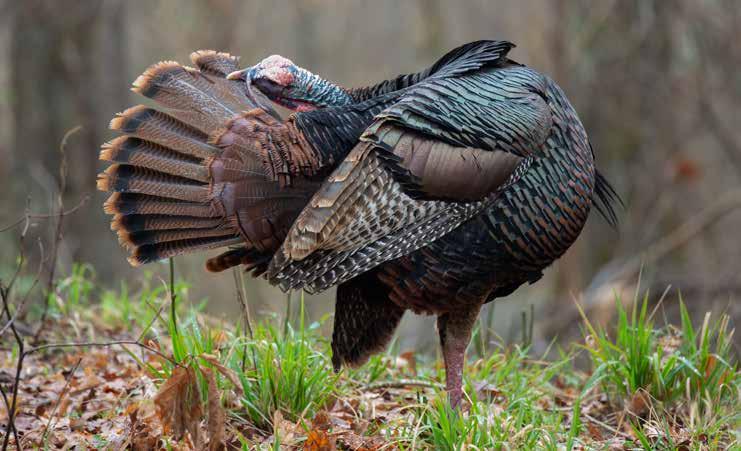
5 minute read
Supersizing Turkey Restoration in Texas

Article by MATT LINDLER, National Wild Turkey Federation
For the first 25 years of the National Wild Turkey Federation’s (NWTF) existence, assisting state agencies with wild turkey restoration efforts was a priority for the organization and its volunteers. The Federation worked hand-in-hand with state agency partners to reestablish turkey populations in areas of suitable habitat, where few or no wild turkeys existed.
The energy among the states, the NWTF and its volunteer base was palpable: People were getting their hands dirty for a good cause, and turkey populations were steadily growing.
When the NWTF was founded in 1973, there were 1.3 million wild turkeys in America. By the early 2000s, wild turkey populations were at their modern-era peak of about 7 million. Target 2000, the turkey trap-and-transfer program, was a huge
Eastern wild turkey releases in Titus County at a super-stocking site identified by TPWD and NWTF. These turkeys were trapped in Missouri and transported to East Texas to bolster wild turkey populations there.

success across the U.S. Gobbles and filled tags abounded hunting season after hunting season.
At the same time, another story was unfolding in East Texas. Early stocking programs from the late 1970s to early 2000s brought wild-caught Eastern Wild Turkeys from neighboring states and from even farther, but the original seeding formula of releasing a flock of 15 to 20 birds comprised mostly of hens with a few gobblers didn’t take off as it did in many other parts of the country.
No one knows for sure why turkeys in East Texas didn’t thrive and grow as their counterparts did in similar habitat. Some point to low poult survival following restocking efforts as one cause and heavy predation on nesting hens as another.
“Habitat also plays a factor,” said Annie Farrell, NWTF district biologist in Texas and Oklahoma. “The Pineywoods of East Texas is a pyric ecosystem, meaning it depends on fire, and the lack of it has led to habitat that is way too thick for turkeys to survive.”
Through active habitat management, the NWTF and Texas Parks and Wildlife Department are working together to address this issue and give the translocated birds the greatest chance of success. In just the past decade, the NWTF and TPWD have accomplished more than $5 million in work on public and private lands, impacting at least 150,000 acres of habitat in Texas to benefit wild turkeys and other species.
Habitat is always the most critical factor in the restoration and management of a species, explained Jason Hardin, TPWD’s wild turkey program leader.
“Once habitat is suitable, controlling predators can also play a role when in restoration mode,” Hardin said. “Another issue, which is beyond our control, is that Texas marks the westernmost edge of the Eastern Wild Turkey’s historic range. This may have influenced the success of past restocking efforts.”
In recent years, however, a new approach is showing some promise. TWPD has embarked on a super-stocking program, where its staff intensively restock birds in three designated focal areas in East Texas. For example, the goal for 2020, was releasing 160 Eastern Wild Turkeys (80 per site) in two targeted release sites. These turkeys predominantly came from North Carolina, where USDA’s Animal and Plant Health Inspection Service personnel trapped them on airport properties where they posed a safety hazard. Some also came from Missouri and West Virginia.
“Stocking in higher quantities provides a number of benefits to help encourage population sustainability and growth,” Farrell said. “First, this helps the restocked birds overcome typical mortality levels and poor nest success often seen the first year the birds are released. During block stocking, it was

Photo by Jami Linder Photo by Russell A. Graves

Photo by Jami Linder


common to lose all the toms restocked before the breeding season ever began. The super stocking approach, however, assures that an ample number of birds survive going into years two and three.”
There’s also security in numbers in the fall and winter when wild turkeys congregate and flock together in segregated gobbler flocks and hens/young flocks. This provides some protection from predators. Also, more gobblers breeding hens and more hens laying eggs means more opportunities for successful nesting, poult survival and recruitment, juveniles that survive the first year and become adults in the population.
Photo by Jami Linder

Photo by Jami Linder

While there are limited hunting opportunities in 13 counties in East Texas, most of the region no longer offers turkey hunting opportunities. NWTF hopes to assist TPWD in creating more hunting opportunities in the region through this intensive restocking program.
“The Eastern Wild Turkey once occupied up to 60 million acres in East Texas,” Hardin said. “Texas hunters, through their purchase of hunting licenses, are footing the bill for the restocking efforts.”
To date, the vast majority of funds tied to the restocking of this valuable bird have come from the purchase of TPWD’s $7 Upland Game Bird Stamp.
“Many of Texas’ citizens will ultimately benefit from the success of this restocking effort, but hunters will have once again paved the way,” Hardin said.
Sustainable populations resulting in the survival of adult wild turkeys, their nests and recruitment of poults into the population are critical if we are to one day open turkey hunting seasons in more areas across East Texas, Hardin explained.
“Wild turkey hunting currently provides close to $64 million annually to rural Texas communities,” he said. “Expanding hunting opportunities in East Texas will benefit hunters and landowners, and will, in turn, improve habitat for many game and nongame species that share the wild turkey’s range.”
Originally published February 2020 at NWTF.org. Used with permission.










